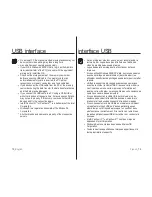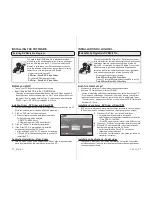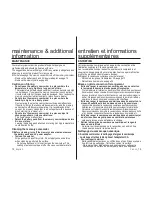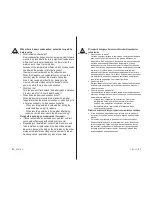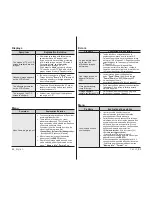
French_
77
77
_English
S-VIDE O
VIDEO
AUDIO
L
R
VIDEO
AUDIO
L
R
VIDEO
AUDIO
Red
White
Red
Yellow
White
White
Yellow
B
G
W
W
W
W
R
R
R
R
Y
Y
Y
Y
Stereo Type with
S-VIDEO Jack
Stereo Type
Monaural Type
S-VIDEO
VIDEO
L-AUDIO-R
INPUT
Memory Camcorder
Normal TV
Multi-AV cable
Signal fl ow
connection
You can view the recorded movie on a large screen by connecting the
memory camcorder to a TV.
VIEWING ON TV SCREEN
Connecting to a TV
Use the provided multi-AV cable to connect
the memory camcorder to a TV as follows:
* If your TV has an S-VIDEO input jack, you
can connect the S-VIDEO plug into it. Even
if you use an S-VIDEO input jack,
you need to connect an audio cable.
Viewing on TV Screen
1.
Turn on the TV and set the input selector to the
Input connection the memory camcorder is
connected to. This is often referred to as “line”.
- Refer to the TV instruction manual for how to switch the TV input.
2.
Turn the memory camcorder on.
-
Slide the POWER switch downward and press the MODE button to set Player ( ).
➥
page 21
- The image that the memory camcorder is viewing will appear on the TV screen.
- You can also monitor the image on the LCD screen of the memory camcorder.
3.
Perform playback.
You can perform playback, recording or setting the menu while viewing on TV screen.
When the copy-guarded movie is played back, no image will appear on TV
screen.
Information that the memory camcorder is recording will appear on the
TV screen: You can also display only part of information or switch off the
display. Refer to “ TURNING THE SCREEN INDICATORS ON/OFF
(
) ” on page 25, and press the
button to switch the
display status.
•
•
connexion
Using S-VIDEO will deliver clearer playback.
Before connecting, make sure that the
volume on TV is turned down: forgetting this
may cause howling from the TV speakers.
Carefully connect the input and output cables
to the corresponding connections on the
device the memory camcorder is being used
with.
•
•
•
Vous pouvez visionner la vidéo enregistrée sur un grand écran en ra
cordant le caméscope numérique à un téléviseur.
POUR VISIONNER SUR UN ÉCRAN DE TÉLÉVISEUR
Raccordement à un téléviseur
Utilisez le câble multi-AV compris pour raccorder le caméscope
numérique à un téléviseur de la manière suivante :
*
Si votre téléviseur possède une prise S-VIDÉO :
branchez la fi che S-VIDÉO. Même si vous utilisez
une prise S-VIDÉO, vous devez employer un câble
audio en parallèle. you need to connect an audio
cable.
Pour visionner sur un écran de
téléviseur
1.
Allumez le téléviseur et réglez le sélecteur de source d'entrée sur celle utilisée
par le caméscope numérique. Parfois appelé "ligne".
- Reportez-vous au guide d'utilisation du téléviseur pour plus de détails sur la
sélection de la source.
2.
Mettez le caméscope numérique sous tension.
- Faites glisser l'interrupteur POWER vers le bas pour allumer l'appareil, puis appuyez
sur la touche de fonction MODE pour confi gurer le lecteur ( ).
➥
page 21
-
L'image visionnée sur le caméscope apparaît à l'écran du téléviseur.
- Vous pouvez aussi contrôler l’image affi chée sur l’écran LCD du caméscope Mémoire.
3.
Lecture.
Vous pouvez lire, enregistrer ou confi gurer le menu tout en regardant l'écran du téléviseur.
Si vous tentez de lire une vidéo protégée contre la copie, aucune image
n'apparaît à l'écran du téléviseur.
L'information enregistrée par le caméscope apparaît à l'écran du téléviseur.
Vous pouvez affi cher uniquement une partie de l'information ou éteindre
l'affi cheur. Reportez-vous à la section "ACTIVATION DES TÉMOINS
MARCHE/ARRÊT DE L'ÉCRAN (
)" à la page 25, puis appuyez sur la
touche
pour changer l'état de l'affi cheur.
•
•
L'utilisation d'un câble S-VIDÉO améliore la
qualité de la lecture.
Veillez à ce que le volume du téléviseur soit
baissé avant d’en effectuer le raccordement
: cet oubli peut provoquer un ronronnement
provenant des haut-parleurs du téléviseur.
Raccordez avec soin les câbles d'entrée et de
sortie aux prises correspondantes de l'appareil
utilisé avec le caméscope numérique.
•
•
•








